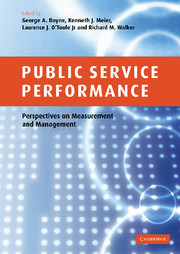Book contents
- Frontmatter
- Contents
- List of figures
- List of tables
- Notes on contributors
- 1 Introduction
- 2 Subjective and objective measures of organizational performance: An empirical exploration
- 3 All measures of performance are subjective: More evidence on US federal agencies
- 4 A qualitative evaluation of public sector organizations: Assessing organizational performance in healthcare
- 5 Quantitative approaches towards assessing organizational performance
- 6 Consequences of goal ambiguity in public organizations
- 7 Performance control and public organizations
- 8 Bureaucratic red tape and organizational performance: Testing the moderating role of culture and political support
- 9 All that glitters is not gold: Disaggregating networks and the impact on performance
- 10 Network evolution and performance under public contracting for mental health services
- 11 The design and management of performance-based contracts for public welfare services
- 12 Outsourcing government information technology services: An Australian case study
- 13 International comparisons of output and productivity in public service provision: A review
- 14 Public management and government performance: An international review
- 15 What drives global e-government? An exploratory assessment of existing e-government performance measures
- 16 Public management and organizational performance: An agenda for research
- Index
- References
13 - International comparisons of output and productivity in public service provision: A review
Published online by Cambridge University Press: 22 September 2009
- Frontmatter
- Contents
- List of figures
- List of tables
- Notes on contributors
- 1 Introduction
- 2 Subjective and objective measures of organizational performance: An empirical exploration
- 3 All measures of performance are subjective: More evidence on US federal agencies
- 4 A qualitative evaluation of public sector organizations: Assessing organizational performance in healthcare
- 5 Quantitative approaches towards assessing organizational performance
- 6 Consequences of goal ambiguity in public organizations
- 7 Performance control and public organizations
- 8 Bureaucratic red tape and organizational performance: Testing the moderating role of culture and political support
- 9 All that glitters is not gold: Disaggregating networks and the impact on performance
- 10 Network evolution and performance under public contracting for mental health services
- 11 The design and management of performance-based contracts for public welfare services
- 12 Outsourcing government information technology services: An Australian case study
- 13 International comparisons of output and productivity in public service provision: A review
- 14 Public management and government performance: An international review
- 15 What drives global e-government? An exploratory assessment of existing e-government performance measures
- 16 Public management and organizational performance: An agenda for research
- Index
- References
Summary
Introduction
This chapter reviews the theoretical and empirical issues involved in undertaking international comparisons of output and productivity (outputs per inputs used) in the provision of public services. The primary focus of the chapter is on performance in aggregate sectors such as health and education, although many of the arguments carry through to more detailed comparisons such as the treatment of specific diseases or types of education. A host of measures of performance are available in the existing literature, from indexes of activity rates to surveys of consumer satisfaction, but there has been little effort to evaluate their relative merits. The purpose of the chapter is both to review existing measures and argue for a unifying framework to ensure that the measures are comprehensive in coverage and place the appropriate weights on various aspects of provision. This framework puts consumer preferences centre stage and draws from the methods employed to measure performance in the private sector.
The chapter begins with a review of existing measures used to evaluate international comparisons of performance, first considering measures for the private sector and then considering available indicators for public services. This highlights the confused picture that emerges for public services in contrast to the useful insights that arise for the private sector. The chapter considers alternative approaches that can be employed for public services and argues in favour of including information on final outcomes.
- Type
- Chapter
- Information
- Public Service PerformancePerspectives on Measurement and Management, pp. 233 - 253Publisher: Cambridge University PressPrint publication year: 2006
References
- 6
- Cited by



